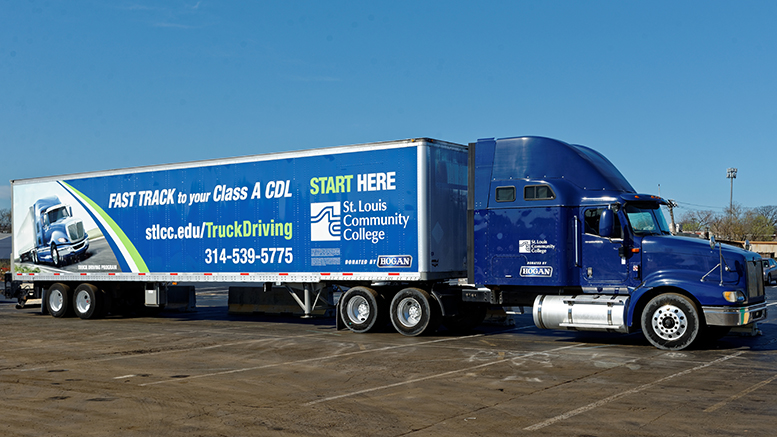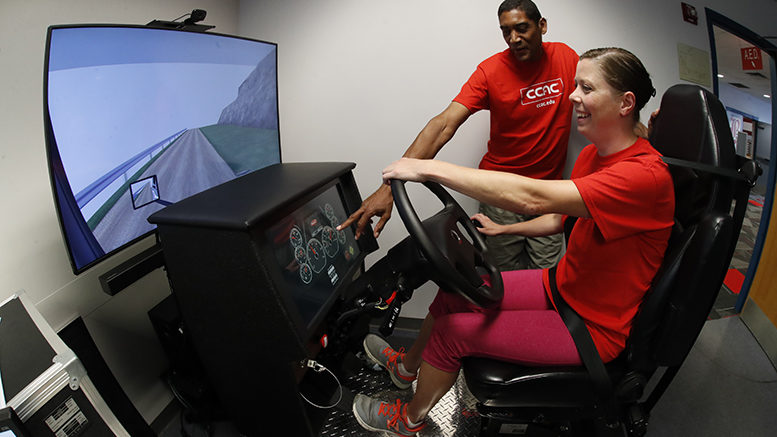Supply chain issues have put a spotlight on the need for skilled truck drivers. According to the American Trucking Association (ATA), there’s a shortage of 80,000 truck drivers. Luckily, many community colleges have been offering this training for years – and some colleges are starting new programs to meet the demand.
Community College of Allegheny County (CCAC) runs an eight-week commercial driver’s license (CDL) training program. The program is at capacity.
“Our enrollment is through the roof,” says Darius Markham, the Pennsylvania college’s CDL coordinator.
The program has capacity for 14 people every four weeks, and classes are filled at least through March. That makes sense since getting a job is almost a guarantee for a program completer.
Markham says he jokes with students that once they get their CDL, “don’t walk too close to an alleyway” or a company owner might snatch them up for a job.
Pay is good, too. The average CCAC program completer makes around $40,000 to $45,000 a year. And as the demand for licensed, skilled drivers goes up, so do pay and benefits. Wages are going up “almost weekly,” Markham says, and many companies are now offering benefits, such as health insurance and 401K matches, starting on day one.
Some of the bigger companies, such as UPS, used to require a few years of experience before hiring drivers, but they are easing up on some of those requirements.
More recruiters than students
Rene Dulle is the senior program manager for environmental and transportation programs at St. Louis Community College. She’s been involved with a lot of job training programs, “but I’ve never like anything like this, where demand for this position is so strong.”
When companies send recruiters to talk with CDL students at STLCC, they often outnumber the students in the class.
“People who complete our program have almost endless choices in where they want to work,” she says.
With a Class A CDL, drivers can take on long-haul driving jobs or work for companies with shorter, local routes. STLCC also provides training for public works employees who drive trucks with heavy equipment.
This week’s poll: Training truck drivers
Randolph Community College (RCC) in North Carolina is just starting a truck driver training program, in partnership with Sandhills and Central Carolina community colleges. There’s a shortage of 12,000 drivers in the state.
“It’s an expensive undertaking,” says Elbert Lassiter, RCC vice president of workforce development. By partnering on the program with other colleges, not only can they offset the costs, but also serve more students in the region. “We have two partners with the same mission.”
Starting Jan. 24, RCC will offer a weeklong CDL permit class designed to teach the skills to get a CDL. The permit is required to enroll in RCC’s CDL truck driver training course that’s planned for later this spring. The college will have the capacity to train 12 students.
RCC will start by offering the program once a year and refer prospective students to its partner colleges for training when the program isn’t running. The hope is to eventually offer the program more frequently.
The typical student enrolled in truck driving programs is male and ranges in age from their late 20s to 50. (Truckers can’t drive across state lines until age 21.) But CDL students are getting more diverse. Women comprise 7.8% of the nation’s drivers – an all-time high – and non-Whites account for 42.3% of truck drivers, according to ATA.
“We’re seeing a lot of women who choose this as a career because, after a short training, they can make a family-sustaining wage,” Markham says.
Many enrollees are looking for a career change and see trucking as “a very resilient industry,” says STLCC’s Dulle.
Funding financial assistance
But there are some barriers to entry – cost being a big one. CDL truck driving programs can be pricey for students. Because they’re short-term, non-degree programs, students aren’t eligible for federal Pell grants.
STLCC works with interested students and “normally there’s a way” to help people afford the program, says Dulle. There are funding options for people who are low-income or lost their jobs, and Missouri’s Fast Track Workforce Incentive Grant provides funding that doesn’t have to be repaid if grant recipients work in the state for three years after graduating. Also, many trucking companies offer tuition reimbursement, and the PepsiCo Foundation assists students from underserved areas, Dulle adds.

At CCAC, a grant from the U.S. Department of Transportation’s Federal Motor Carrier Safety Administration provides no-cost training for current and former members of the U.S. armed forces, including National Guard members and reservists, as well as certain military family members. The grant will cover the cost of training 31 people.
And Randolph Community College is working with its local workforce development board to ensure people from underserved communities can afford the training.
Tapping a new grant
There are barriers for colleges, too. The cost of equipment is staggering, Lassiter says. Trucks are a huge expense, and fewer trucks means smaller class capacity.
A $250,000 grant from the Cannon Foundation will help with start-up costs for the program at RCC and its partner colleges. The funding will help to purchase trucks and resources for classroom training, as well as half of the program coordinator’s salary. The three colleges will cover the other half.
The partners also are applying for another grant from a foundation in North Carolina, which would allow them to purchase more equipment and expand capacity.
“The additional funds would give us enough resources to run two programs at two of the three colleges, simultaneously,” says Randy Gunter, RCC dean of workforce development and continuing education. “This would allow us to run at least two programs per year at each college for a total of six in the region.”
Gunter adds, “The end goal is to eventually have enough resources at each college that we can run the program year-round at each school. The beauty of this collaboration is that the grants and collaboration of resources is helping each college start this program and get the programs up to speed for the training that the industry needs.”
Covid-related challenges
At STLCC, Dulle has applied for several grants to get new equipment. She’s got two new automatic trucks coming – many companies are switching from manual to automatic trucks – and she’s applied for a grant to fund lights for the parking lot so training can take place at night.
Pre-Covid, STLCC’s program had a capacity of eight students per class. Now, with the need for social distancing, they’ve cut down to four people per class. That means a loss in revenue.
CCAC’s CDL program shut down for nine weeks at the start of the pandemic in 2020. It was the last program to shut down, and it was the first program to move back to in-person learning, according to Markham. Pre-Covid, the program had already transitioned from four students per truck to two students per truck, with an instructor.
“Since we were already at low number, we’ve been able to continue our operations the way we had been,” Markham says.
The CCAC program also has four new simulators, so when a student is having trouble in the truck, they can move to a safer environment.
“If I put them in a simulator and they make a mistake, I get to hit the reset button,” Markham says. The simulators hold information “so I can do a replay and they can see where they make mistakes.”
He adds that the simulators are a great marketing tool.
Seeking instructors
But an even bigger issue for the colleges right now is finding instructors. The companies that look to the colleges to train drivers are also hiring people who would be qualified instructors.
“It’s a challenge for us to grow and expand for that reason,” Dulle says. “To help the industry, we need help, too.”
Dulle hopes some of the program graduates will return to STLCC, this time as instructors.
“We’ve been running our program over six years, and we can finally look at some of our grads and see if some might consider becoming faculty,” she says.

